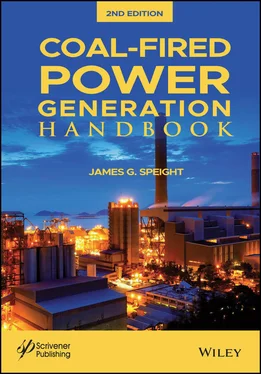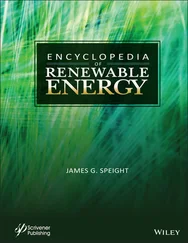It is helpful for the scientist or engineer working with coal to understand the various systems so that, for example, the scientist or engineer working with coal to produce electricity can immediately understand reference to coal type made by their counterparts working in other countries who use different classification systems.
Coal occurs in different forms or types ( Table 2.1). Variations in the nature of the source material and local or regional variations in the coalification processes cause the vegetal matter to evolve differently. Thus, various classification systems exist to define the different types of coal. In addition to being defined as a sedimentary rock, coal has also been considered to be a metamorphic rock , which is the result of heat and pressure on organic sediments such as peat. However, the discussion in favor of coal as a sedimentary rock is because most sedimentary rocks undergo some heat and pressure and the association of coal with typical sedimentary rocks and the mode of formation of coal usually keeps low-grade coal in the sedimentary classification system. Anthracite, on the other hand, undergoes more heat and pressure and is associated with low-grade metamorphic rocks such as slate and quartzite. Subducted coal may become graphite in igneous rocks or even the carbonate rich rocks (carbonatites).
The degree of metamorphosis results in differing coal types, each of which has different quality. However, peat is not actually a rock but no longer just organic matter and is a major source of energy for many non-industrialized countries. The unconsolidated plant matter is lacking the metamorphic changes found in coal. Thus, coal is classified into four main types, depending on the amount of carbon, oxygen, and hydrogen present. The higher the carbon content, the more energy the coal contains. Thus, as geological processes increase their effects over time, the coal precursors are transformed over time into coal, each coal type having different properties from the other types ( Table 2.1).
Coal classification systems are based on the degree to which coals have undergone coalification. Such varying degrees of coalification are generally called coal ranks (or classes ). The determination of coal rank has a number of practical applications such as the definition of the coal properties. The properties include the amount of heat produced during combustion, the amount of gaseous products released upon heating, and the suitability of the coals for producing coke.
Some of the classification systems are currently in use in several countries and include: the American Society for Testing and Materials (ASTM) system (used in North America), the National Coal Board (NCB) system (UK), the Australian system, and the German and International Systems (for both hard and soft coal) classifications (Carpenter, 1988; Speight, 2013). Each system involves use of selected coal properties (chemical, physical, mechanical and petrographic) as the determining factors leading to classification of coal but the variation of these properties can lead to a poor fit of a coal within the relevant classification system. It is not the purpose to enter into such details here but to give a general description of the ASTM system and the classification systems that relate to the United States through coal trade and other aspects of coal technology.
Generally and from the mineralogical aspects, coal can be defined (sometimes classified) as an organic sedimentary rock-like natural product. The resemblance of coal to a rock is due to the physical nature and composition of the coal as well as the inclusion of a natural product term in a general definition and is not an attempt to describe coal as a collection of specific, and separate, natural product chemicals. Such chemical species are universally recognized (for example, see Fessenden and Fessenden 1990; Ramawat and Merillon, 2013) and are more distinct chemical entities with more specific use than coal.
However, the designation of coal as a natural product is no stretch of the truth and arises because of the oft-forgotten fact that coal is the result of the decay and maturation of floral remains (which are natural product chemicals) over geologic time. Indeed, the organic origins and the organic constituents of coal are too often ignored (Speight, 2013). But there are more appropriate definitions of coal and the manner by which this complex natural product can be classified.
The need to classify coal arose in order to describe each individual sample of coal in terms that would accurately (even adequately) depict the physical and/or chemical properties (Kreulen, 1948; van Krevelen and Schuyer, 1957; Francis, 1961). Consequently, the terminology that came to be applied to coal essentially came into being as part of a classification system and it is difficult (if not impossible) to separate terminology from classification to treat each as a separate subject. This is, of course, in direct contrast to the systems used for the nomenclature and terminology of crude oil, natural gas, and related materials (Speight, 2011, 2014, 2020). Indeed, coal classification systems stand apart in the field of fossil fuel science as an achievement that is second to none insofar as the system allows classification (on the basis of standardized parameters) of all of the coals that are known.
Of particular importance here is the carbon content of the coal, which is part of the basis for the modern classification system of coal, Thus, whereas crude oil does not exhibit a wide variation in carbon content – all of the crude oil, heavy crude oil, extra heavy crude oil and tar sand bitumen (sometimes incorrectly referred to as natural asphalt) that occur throughout the world fall into the range of 82.0 to 88.0% w/w – coal, on the other hand exhibits a wide variation in carbon content – all of the coal types in the world have carbon contents varying over the range 75.0 to 95.0% w/w (Speight, 2013, 2014, 2020). While little room is left for the design of a standardized system of crude oil classification and/or nomenclature based on carbon content, the door is wide open for coal to be classified using carbon content as one of the parameters.
However, before launching into a discussion of the means by which coal is classified, it is perhaps necessary to become familiar with the nomenclature (the equivalent terms nomenclature and terminology are used synonymously here) applied to coal even though this terminology may be based on a particular classification system or may simply be described as the grade of coal .
Briefly, coal grade is a term used to indicate the value of coal material as determined by the amount and nature of ash yield and the sulfur content following the complete oxidation of the organic fraction. Calorific value is one of the principal measures of the value of coal as a fuel and is directly influenced by mineral impurities. Coal mineralogy is not only important to combustion characteristics, but also as materials that can be passed on to secondary products such as metallurgical coke. Alkalis-containing compounds derived from coal minerals can contribute to excessive gasification of coke in the blast furnace and attack of blast furnace refractories, whereas phosphorus and sulfur from coal minerals can be passed on to the hot metal, thus reducing the quality of the coal for steelmaking.
For example, within certain parts of the industry, coal is classified (or described) as two main categories: (i) high-grade coal and (ii) low-grade coal, which refers to the energy content of the coal. Among high-grade coals are anthracite and bituminous coal while low-grade coals include subbituminous coal and lignite. On the other hand, the grade of Indian coal is based on the calorific value of the coal ( Table 2.2).
Читать дальше












